{KomentoDisable}
B. Map Elements
A map consists of other components besides the graphic representation. Because a map is a communication medium, it must contain sufficient support information to make it self-explanatory. The user should understand the map's contents and information quality.
1. All Maps
Whatever the type, whether manually or digitally produced, there are some parts common to all maps.
a. Title or Name
The title should be descriptive of map content. The title may be up the map compiler, or may be defined by policy, or, in the case of a legal map, by law.
A United State Geologic Survey (USGS) 7-1/2 minute topographic quadrangle (topoquad) is named after a local community or prominent feature. Figure B-1 is the topquad which contains Cuba City Wisconsin.
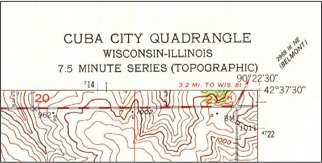 |
| Figure B-1 Topoquad Title |
In Wisconsin, a Certified Survey Map (CSM) must be so identified. When the map is recorded, it is assigned a sequential number which creates a unique name for the map, Figure B-2.
 |
| Figure B-2 CSM Title |
The title is also required to identify the Public Land System (PLS) quarter-quarter Section within which the CSM is located.
A map title may include the map's purpose, Figure B-3.
 |
| Figure B-3 Map Title |
b. Graphic Elements
Because it is an abstraction, a map depends on graphic elements to portray features: symbols, line types, and colors. These serve as graphic shorthand allowing complex features to be shown in simplified form and allow quick visual interpretation.
Figure B-4 is a portion of a Wisconsin Department of Transportation (WIDOT) State Highway map.
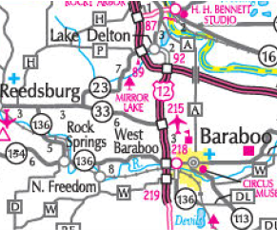 |
| Figure B-4 Wis State Highway Map |
Roads are shown as linear elements. Their line type, size, and color communicate different road classifications. Roads are in their correct planimetric location, but sizes are exaggerated for interpretive purposes; if plotted at actual widths all would appear as faint lines.
Figure B-4 also uses symbols for point features. Some are immediately recognizable, like the plane for an airport. Others may not be obvious: hollow triangle, solid square, solid square with a pennant, etc. For a map to be effective, the user must understand what its symbols represent. For that, a legend is used. The legend includes all map symbols, linear elements, colors, etc, and what they mean. Figure B-5 is the legend for Figure B-4.
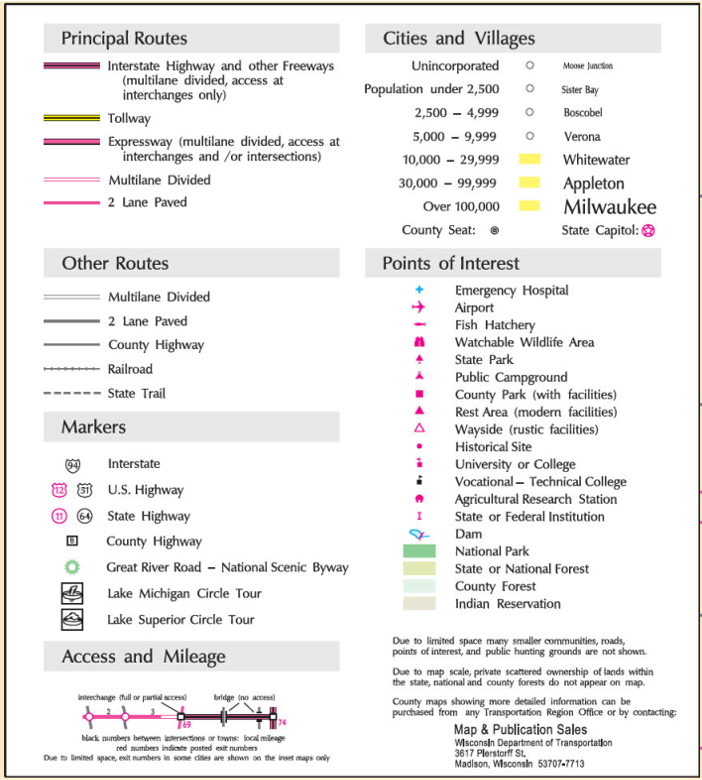 |
| Figure B-5 WIDOT State Highway Map Legend |
Legend content and complexity are a function of the graphic elements used on the map. It can be lengthy, like Figure B-5, or short, like Figure B-6 from a legal map.
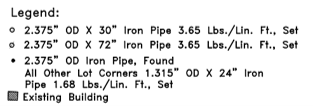 |
| Figure B-6 Legend from a Legal Map |
If a short legend is used, the map may need other support information to ensure graphics are correctly interpreted.
c. Orientation
Orientation is the map content relationship to north. Most people assume north is "up" on a map held upright. A North Arrow must be included on a map so the user does not have to assume. Figure B-7 is the North Arrow from the WIDOT State Highway map.
 |
| Figure B-7 WIDOT State Highway Map North |
Unfortunately, there isn't a single "north"; there's geodetic, true, magnetic, grid, even assumed. Which is Figure B-7 based on? When orientation is given on a map, so should its basis. The North Arrow in figure B-8 is from a legal map and uses an assumed direction for a particular quarter Section line.
 |
| Figure B-8 North from a Legal Map |
Figure B-9 shows three different Norths on a map and their angular relationships.
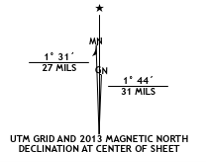 |
| Figure B-9 Multiple Norths |
GN: Universal Transverse Mercator (UTM) Grid North
MN: Magnetic North
*: Astronomic North
Because it changes irregularly over time, Magnetic North is rarely used as the only orientation for a map.
d. Scale
Scale is the relationship between a feature's size on a map and its actual size. A map should have a uniform scale in all directions: one unit in the x direction on the map represents the same ground distance as one unit in the y direction.
Scale can be expressed as a statement or graphically, examples of which are shown in Figure B-10.
 |
| Figure B-10 Scale Examples |
In traditional manual drafting, scale was an important initial consideration because reality had to be reduced to fit on a physical piece of paper. In a modern digital mapping environment where everything is drawn full-size, it would seem that scale isn't a consideration, but it is.
Scale is extremely important in map compilation and data collection. The next chapter discusses scale in greater depth.
2. Other Elements
a. Labels
Labels are used on non-metric maps that indicate relative positioning, Figure B-11, or serve as indices to other information resources, Figure B-12.
 |
| Figure B-11 State Labels |
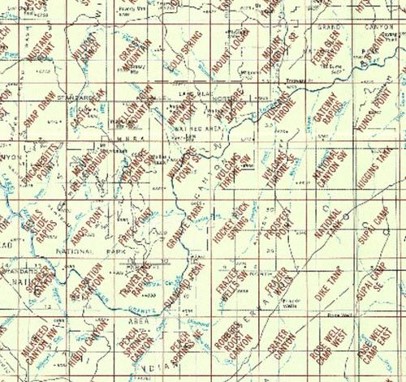 |
| Figure B-12 Topoquad Index Map |
Labels are also used on metric maps to identify features, dimensions, and other salient features.
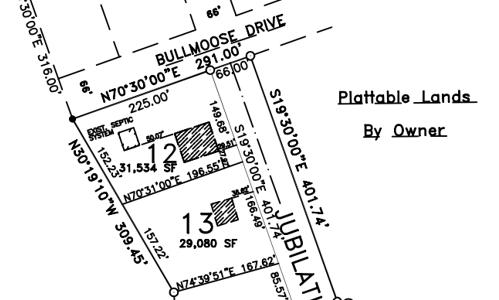 |
| Figure B-12 Metric Map Labels |
Labels on the legal map in Figure B-12 include:
- Parcel line lengths and directions
- Street names and widths
- Adjacent landowner reference
- Building locations
- Septic system identification
b. Spatial Reference Systems
If a formal horizontal coordinate system is used on a map, it should be identified. USGS topoquads usually have two or more coordinate systems and are identified as in Figure B-13.
 |
| Figure B-13 Topoquad Coordinate Reference |
The coordinate system reference should include its datum and units.
Similarly, if elevation information is shown on the map, the vertical system and units should be stated. Figure B-14 is typical for USGS topoquads.
| Figure B-14 Topoquad Vertical Reference |
Figure B-15 is from a WIDOT plans set.
|
Coordinates on this plan are referenced to the Wisconsin County |
| Figure B-15 From WIDOT Plan Set |
If coordinates or elevation are important map information, their reference should be stated, even if assumed, Figure B-16.
 |
| Figure B-16 Assumed System Reference |
c. Explanatory Notes
Explanatory notes are more detailed than labels. They can provide additional background information, Figure B-17.
 |
| Figure B-17 Data Sources |
While graphic elements represent features, sometimes they are hard to see or are important enough to warrant some additional explanation. Figure B-18, from a legal map, uses a mix of labels and explanatory notes.
 |
| Figure B-18 Multiple Explanatory Notes |
d. Other Elements
A specialty can include other elements unique to that map or its purpose.
Figure B-19 is an example of a specialized map. When the North American Datum of 1983 (NAD 83) was readjusted from the 1997 version to 2007, control station horizontal positions changed. Position shifts were difficult to interpret from the NAD 83 (1997) and NAD 83 (2007) positions provided by the National Geodetic Survey (NGS) in text form.
To examine the readjustment effect in Wisconsin, the shift at each point was computed as a vector having direction and magnitude. These vectors were plotted on a Wisconsin counties map. Because shifts were small (<0.1 meters), vectors were exaggerated to be visible.
 |
| Figure B-19 Datum Readjustment Position Shifts |
The map has a mix of metric and quasi-metric information. Unique items on the map include:
- Statistical summary table
- Detail graphic of example vector
- Vector scale, graphic and relative
Mapping the shifts provided a visual indication of their behavior. It also helps identify outliers: a position shift magnitude and/or direction significantly different from surrounding points. Note the wayward shift in the northwestern part of the state - its vastly differnt magnitude and direction are obvious on the map, not so much in a table.
Depicting the information graphically makes patterns and problems much easier to see than the same data in text form. A map provides us another way to look at data.